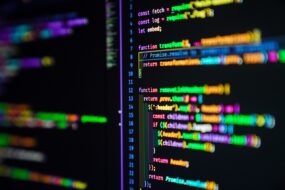
What is Web Development?
At its core, web development involves creating and maintaining websites. It can be broken down into two main categories:
- Frontend Development: This refers to everything that users interact with directly in their web browsers.
- Backend Development: This focuses on the server-side of web development, where all the data processing, storage, and server-side logic happens.
If you’re new to web development, you’ll typically start with frontend development, which is responsible for the design and layout of websites and applications. However, if you aim to become a full-stack web developer, you will also need to learn backend development.
Let’s dive into the tools and languages required for web development.
1. Frontend Development: The Basics
Frontend development focuses on what users see and interact with on a website or application. The primary tools and languages used for frontend development are HTML, CSS, and JavaScript.
HTML: The Structure of the Web
HTML (HyperText Markup Language) is the foundational language for creating web pages. It defines the structure of a webpage by using elements like headings, paragraphs, links, and images. Think of HTML as the skeleton of a website.
- What You’ll Learn: How to structure a webpage, create links, add text, images, forms, and more.
- Resources: Websites like W3Schools and MDN Web Docs offer excellent tutorials for learning HTML.
CSS: Styling Your Website
While HTML provides structure, CSS (Cascading Style Sheets) is used to style your web pages. With CSS, you can control the layout, colors, fonts, and overall design of a website.
- What You’ll Learn: How to create layouts using grid and flexbox, how to apply color schemes, set typography, and much more.
- Resources: Check out the CSS Basics guide on W3Schools or CSS Tricks.
JavaScript: Adding Interactivity
JavaScript is the programming language that makes your website interactive. It allows you to create dynamic elements like image sliders, form validation, and even entire web applications.
- What You’ll Learn: Basic programming concepts like variables, functions, and loops; DOM manipulation; and event handling.
- Resources: Websites like JavaScript.info and MDN JavaScript are great for beginners.
2. Web Development Tools
To streamline your development process and make your work more efficient, web developers use a variety of web development tools.
Code Editors
A code editor is where you’ll write your code. Some popular editors include:
- Visual Studio Code: Lightweight and powerful, with extensions for JavaScript, HTML, and CSS.
- Sublime Text: Fast, customizable, and easy to use for all web languages.
- Atom: Open-source and hackable, great for web developers.
These editors provide features like syntax highlighting, code completion, and version control integration, which help you write and organize your code more effectively.
Version Control
As a web developer, it’s crucial to keep track of the changes you make to your code. Git and GitHub are popular version control systems used to manage and collaborate on code.
- Git allows you to track changes to your code and collaborate with other developers.
- GitHub is a platform where you can store and share your code repositories with others.
Web Browsers and Developer Tools
Testing your web pages is a key part of web development. Popular browsers like Google Chrome, Firefox, and Edge offer developer tools that help you inspect and debug your code directly in the browser.
Use the DevTools in Google Chrome or Firefox to check how your site looks, find bugs, and optimize performance.
3. Full-Stack Web Development: Beyond the Frontend
If you want to become a full-stack web developer, you’ll need to learn backend development as well. Full-stack development involves both frontend and backend technologies.
Backend Languages
While frontend development focuses on the user interface, backend development handles things like data storage and server-side logic. Common backend programming languages include:
- PHP: Widely used for server-side scripting.
- Node.js: A JavaScript runtime for building server-side applications.
- Python: Often used for backend web development with frameworks like Django or Flask.
Databases
A database is where all the data for your website is stored. Popular database systems include:
- MySQL: A relational database used with PHP.
- MongoDB: A NoSQL database that stores data in JSON-like format.
- PostgreSQL: An advanced relational database.
Web Frameworks
Frameworks provide pre-written code to make your development process faster. Some popular frameworks for full-stack web development are:
- React (Frontend)
- Vue.js (Frontend)
- Express (Backend with Node.js)
- Django (Backend with Python)
4. Web Development Resources: Where to Learn
To start learning web development, there are countless resources available online. Here are some top web development resources for beginners:
- freeCodeCamp: Offers free interactive coding lessons in web development.
- Codecademy: Offers interactive courses in HTML, CSS, JavaScript, and full-stack development.
- MDN Web Docs: Mozilla’s official documentation for web technologies.
- W3Schools: A great place for quick reference and beginner tutorials.
- YouTube: Channels like “Traversy Media” and “The Net Ninja” offer fantastic video tutorials on web development.
5. How to Become a Web Developer
Becoming a web developer requires time, practice, and dedication. Here’s a step-by-step approach to getting started:
- Learn the Basics: Start with HTML, CSS, and JavaScript. Build simple static websites to get a feel for how the web works.
- Practice Regularly: Build small projects like a personal website or a to-do list app. Practice is key to improving your skills.
- Learn Version Control: Get comfortable with Git and GitHub to manage your code and collaborate with others.
- Explore Frameworks and Libraries: Once you’re comfortable with the basics, explore frontend libraries like React or Vue and backend frameworks like Node.js or Express.
- Build Real-World Projects: Start building more complex projects that solve real problems. Contribute to open-source projects to gain experience.
- Stay Updated: Web development is constantly evolving. Follow blogs, forums, and online communities to stay up-to-date with the latest trends and technologies.
Conclusion
Web development is a vast field, but with the right tools, languages, and resources, anyone can get started. Whether you choose to focus on frontend development or full-stack web development, mastering the core languages—HTML, CSS, and JavaScript—is the first step in your journey. Use the resources mentioned in this web development tutorial to deepen your understanding and begin building your own websites and applications.
By following this web development guide, you’ll be well on your way to becoming a skilled web developer. So, start learning web development today, and take the first step toward creating the next big web app!




